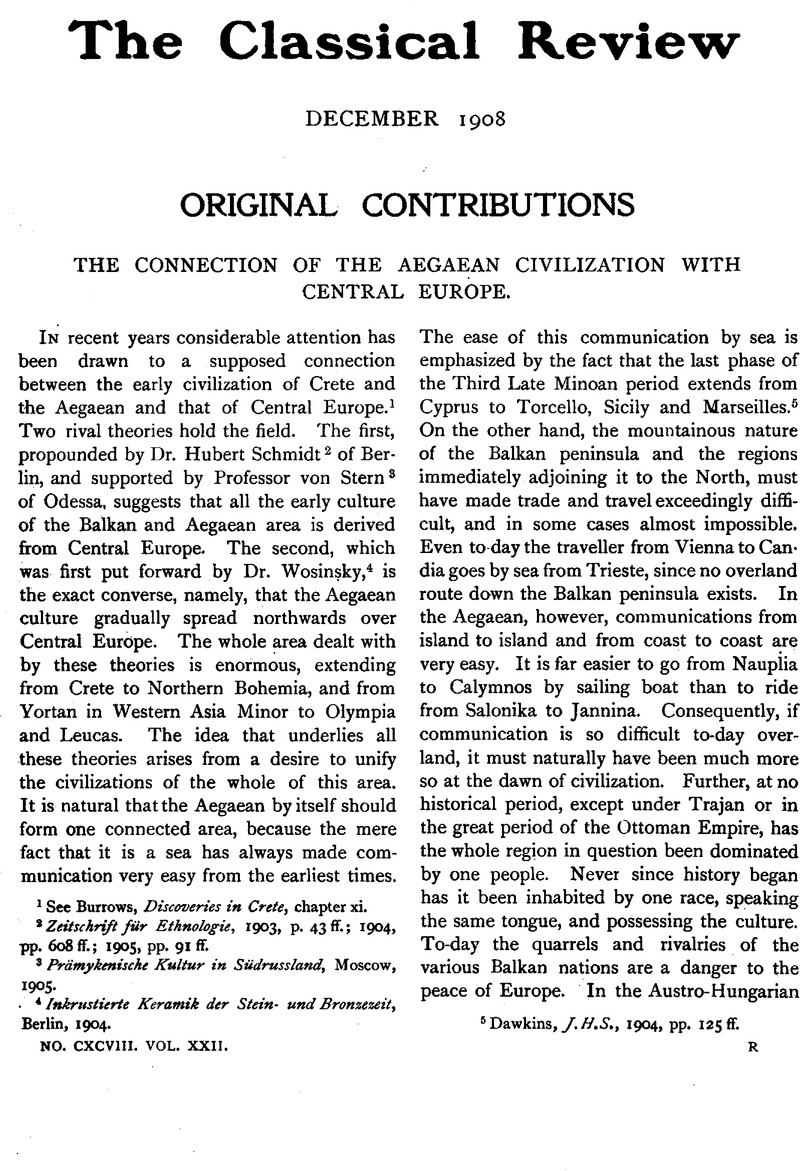No CrossRef data available.
Article contents
The Connection of the Aegaean Civilization with Central Europe
Published online by Cambridge University Press: 27 October 2009
Abstract

- Type
- Original Contributions
- Information
- Copyright
- Copyright © The Classical Association 1908
References
page 233 note 1 See Burrows, Discoveries in Crete, chapter xi.
page 233 note 2 Zeitschrift für Ethnologie, 1903, p. 43 ff.; 1904, pp. 608 ff.; 1905, pp. 91 ff.Google Scholar
page 233 note 3 Prämykenische Kultur in Südrussland, Moscow, 1905.Google Scholar
page 233 note 4 Inkrustierte Keramik der Stein- und Bronzezeit, Berlin, 1904.Google Scholar
page 233 note 5 Dawkins, , J.H.S., 1904, pp. 125 ff.Google Scholar
page 234 note 1 We have to thank Dr. Mackenzie for his great kindness in discussing with us several of the points dealt with in this paper.
page 234 note 2 See the cases in the Ashmolean Museum.
page 234 note 3 Bullettino di Paletnologia Italiana, xvi. pp. 177 ff.; xxix. pp. 91 ff.
page 234 note 4 Chvojka, , Stone Age on the Dnêpr (in Russian); Trans. Russ. Arch. Soc. (Russian section), 1904, v. 2Google Scholar. A good account in English of these finds will appear in MrMinns', book, Greeks and Scythians, pp. 132 ff.Google Scholar
page 234 note 5 Minns, , op. cit. p. 141.Google Scholar
page 234 note 6 Early Age of Greece, p. 274.
page 234 note 7 Annals of Archaeology and Anthropology, vol. i. 1908.Google Scholar
page 235 note 1 See Mackenzie, , J.H.S. 1903, pp. 157 ff.; 1906, pp. 243 ff.Google Scholar
We give no detailed account of the Cretan finds, since they are easily accessible in Dr. Evans' reports on Knossos, in those of Bosanquet and Dawkins on Palaikastro in the Annual of the British School at Athens, vol. vi. sqq., and in those of Dr, Halbherr, Google Scholar and his collaborators in Monumenti Antichi, 1902, vol. xiiGoogle Scholar.; 1905, vol. xiv. A good summary is given by Prof. Burrows in his book, The Discoveries in Crete.
page 235 note 2 See Excavations at Phylakopi.
page 235 note 3 Dawkins, , J.H.S. 1904, pp. 125 ff.Google Scholar; Bosanquet, , J.F.S. 1904, pp. 317 ff.Google Scholar
page 236 note 1 Phylakopi, chapter viii. (Bosanquet).
page 236 note 2 Although Melos is the sole Aegaean source, obsidian is found in Tokay, the Caucasus, and Russian Armenia, whence it may have reached Central Europe. Consequently we cannot be sure how much of the obsidian found outside the Aegaean area is of Aegaean origin. Although a ship would carry Melian vases as well as obsidian, on a difficult overland route everything fragile, such as vases, would be left behind, and only the easily portable and unbreakable obsidian carried up country.
page 236 note 3 Ath. Mitt. 1906, p. 205; 1907, p. iv; 1908, p. 185; ![]() , p. 386, 1.
, p. 386, 1.
page 236 note 4 For finds in Nortll Greece see ![]() ; Sotiriadhis, Ath. Mitt. 1905, pp. 120 ff.; 1906, pp. 396 ff.;
; Sotiriadhis, Ath. Mitt. 1905, pp. 120 ff.; 1906, pp. 396 ff.; ![]() . 1908, pp. 65 ff.; Bulle, Orchomenos, i.
. 1908, pp. 65 ff.; Bulle, Orchomenos, i.
page 236 note 5 Seure-Degrand, , B.C.H. 1906, pp. 359 ff.Google Scholar
page 236 note 6 Cf. Hoernes, Urgeschichte der Bildenden Kunst, pl. iii.; cf. Δσο⋯ντας, op. cit. pl. xxxi., xxxii.
page 236 note 7 See Dörpfeld, Troja und Ilion.
page 236 note 8 Comptes Rendus de l'Acad. d. inscr. et belles lettres, 1901, pp. 810 ff.Google Scholar
page 236 note 9 Körte, A., Ath. Mitt. 1899, pp. 1 ff.Google Scholar
page 237 note 1 For the Bosnian finds see Hoernes, , Neolitische Keramik in Oesterreich (Jahrb. d. K.K. Zentral-Kommission, iii. 1905), pp. 7 ff.Google Scholar; Mitt. aus Bosnien u. der Hercegovina, iv. pp. 39 ff.; v. pp. 124 ff.Google Scholar; vi. pp. 129ff.; Hoernes-Radimsky, , Neolitische Station von Butmir, Vienna, 1895;Google Scholar for the Servian finds see Vasić, Rev. Arch. 1902, pp. 172 ff.; 1908, pp. 205 ff.; Starinar, 1906, pp. 1 ff.; 1907, pp. 1 ff.
page 237 note 2 Hoernes, , Urgeschichte der bild. Kunst, pl. iv.Google Scholar
page 237 note 3 See Chvojka, von Stern and Minns, op. cit.; for the Galician finds see Hoernes, Neolitische Keramik, pp. 114 ff.
page 237 note 4 E.g. Chvojka, pl. xxii.
page 237 note 5 Schmidt, , Zeit. f. Ethn. 1903, pp. 438 ff.Google Scholar
page 237 note 6 Wosinsky, Prähistorische Schanzwerk von Lengyel.
page 237 note 7 Hoernes, , Neolitische Keramik, p. 72.Google Scholar
page 237 note 8 The sherds discussed by Schmidt (Zeit. f. Ethn. 1905, pp. 91 ff.Google Scholar), do not come from any scientific excavation (cf. Traeger, ibid. 1902, pp. 62 ff.). Dr. Kinch informs us that prehistoric mounds are common in Macedonia proper and Chalcidice, and that he is preparing an account of them, with plans, etc.
page 237 note 9 Some finds have been made near Jassy, , Zeit. f. Ethn. 1904, p. 643Google Scholar; Stern, von, op. cit. p. 77Google Scholar;. Hoernes, , Urgeschichte der bild. Kunst, pp. 210 ff.Google Scholar
page 238 note 1 Cf. Mackenzie, B.S.A. xii. p. 257.


